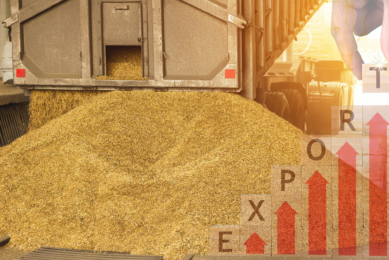Weather impacts Turkey’s feed grain market

May 2021 was the warmest May in the last 50 years in Turkey. Unexpectedly dry weather conditions between April and June caused wheat yield and quality losses. Meanwhile, favourable weather conditions in May/June resulted in better corn yields., all impacting Turkey’s grain feed market.
Better corn yield due to good weather
Although corn planting area forecast is down about 12% to 540,000 hectares, favourable weather conditions in May/June after planting resulted in better corn yield expectations in Turkey. Corn production forecast for MY 2021/22 is therefore 6.8 mmt.
Meanwhile, domestic corn consumption in Turkey is projected at 9.3 mmt, 500,000 mt more than last year, assuming increased demand from the feed sector and starch industry. Livestock feed and residual corn consumption forecast is 8,000 mt.
Corn imports for the first 9 months of MY 2020/21 (from September to May) reached about 1.7 mmt. The main suppliers were:
– Russia (878,000 mt)
– Ukraine (493,000 mt)
– Romania (160,000 mt).
The Turkish Grain Board imported about 1 mmt of corn in MY 2020/21 to meet the domestic demand and stabilise domestic corn prices. Turkey’s corn import forecast is 2.8 mmt to meet demand from feed and starch sector in MY 2021/22.
Some farmers even decided not to harvest their fields because of poor yield.
Mass barley yield losses result from poor rainfall
Barley fields are typically unirrigated and yields are directly linked to rainfall. Barley production for MY 2021/22 is forecast down to 4.5 mmt from an original forecast of 7.7 mmt due to mass yield losses related to poor rainfall. Some farmers even decided not to harvest their fields because of poor yield.
Barley imported for feed
On assumptions that 2.75 mt of barley will be imported to meet demand from the feed sector, Turkey’s barley consumption forecast for MY 2020/21 is projected at 7.5 mmt due to the sharp decrease in production.
After the announcement of intervention prices mentioned above, TMO was very active in the barley market with tenders and sales. TMO imported about 760,000 MT of barley with two issued tenders in June and July 2021 to stabilize the domestic barley price. TMO also announced sales of barley in its stocks to the feed sector at 1,950 TL/MT ($227).
Turkey’s barley export forecast for MY 2021/22is 30,000 mt due to limited demand from neighbouring countries.
Up to 70% wheat losses
May 2021 was the warmest May in the last 50 years in Turkey. Unexpectedly dry weather conditions between April and June caused yield and quality losses – up to 70% in some areas. Total wheat production forecast is therefore 16.5 mmt for MY 2021/22.
Meanwhile, wheat planting is forecast to decrease to 7 million hectares, down 100,000 hectares (ha) compared to MY 2020/21. Farmers have complained about low domestic prices, despite sharply increased input costs which affected crop selection.
The feed sector is purchasing all classes of wheat at competitive prices.
In terms of consumption, the feed sector is purchasing all classes of wheat at competitive prices. Most of the wheat, however, is utilized for human consumption, with the rest of the wheat used as feed.
For MY 2021/22, Turkey’s wheat import forecast is 11.25 mmt, a record high level due to demand from the domestic market and a smaller harvest than expected. Total wheat exports from Turkey for MY 2021/22 are forecast at 6 mmt, down 300,000 mt from MY 2020/21.
Turkey imported about 8.15 mmt of wheat in MY 2020/21. The main suppliers were:
– Russia (6.3 mmt)
– Ukraine (740,000 mt)
– Canada (250,000 mt)
The Turkish Grain Board (TMO)’s duty-free tenders to meet domestic demand and demand from wheat product producers are the main driving force of imports since commercial importers can’t compete with the high tariffs.
The information in the article has been extracted from a USDA GAINS report.











